Abstract
The current study of Al alloys aims to improve their high-temperature mechanical properties by forming intermetallic precipitates with high-temperature stability. Using rare earth elements (RE) to achieve this goal increases the production cost and, hence, minimizes the economic advantage of the conventional casting processes. Therefore, alternative additives/methods with reasonable costs become mandatory. Al-Ce alloys were found to be a promising group of alloys. Cerium is the most economically abundant RE that can be added to aluminum alloys. The main intermetallic phase, i.e., Al11Ce3, is characterized by its high-temperature stability compared to other Al-based intermetallic compounds. Several research works modified the morphology of the stable Al11Ce3 phase to enhance the high-temperature properties of Al-Ce alloys. These methods were heat treatment, chemical modification, and solidification processing. This review article summarizes the “few” available research works, that studied the influence of solidification processing on the microstructure features of Al-Ce alloys. Among the solidification processing techniques available, special attention was given to microstructure processing via ultrasonic treatment and the corresponding effects on mechanical properties and electrochemical behavior. Future research points were also proposed.
1. Introduction
Al-based alloys containing intermetallic particles are widely used in automotive and aerospace industries to meet regulatory and economic pressures, hence reducing energy consumption while maintaining a reasonable manufacturing cost. The strength of the major group of these alloys depends on the formation of precipitates during heat treatment [1]. However, upon exposure to high temperatures that exceed ~250 °C for extended periods, this strengthening mechanism fails. This failure principally occurs due to the instability and growth of these precipitates and their dissolution in the aluminum matrix [2]. Even the cast Al-Si group, which contains thermally stable eutectic Si particles, reported creep failure cases [3] because of the little strength they provide to the host Al matrix. This problem was overcome by adding rare earth elements (RE) that refine the cast microstructure, enhance the mechanical properties, and increase the melty fluidity [4]. The diffusion coefficients of these RE in Al matrix was found to be one-third and one-fourth that of Mg and Si [5,6], respectively. Recently, more focus was placed on the elemental Ce, which is the most discarded RE, despite its economic feasibility as a means of mass production [7].
What distinguishes Al-Ce intermetallic phases is their unique ability to maintain their shape and size after exposure to high-temperature treatment. This ability is due to the thermally stable intermetallic phases that form. In the work of Belov and Khvan [8] on Al-Ce-Cu system, it was detected that Al and CeCu4Al8 (eutectic) phases do not grow with heating and are capable of fragmenting to a maximum size of 1–2 μm after being annealed to 590 °C. In another study [9], an Al-16Ce-8Ni alloy showed a microstructure that contained finely dispersed and spheroidized Al4Ce and Al3Ni eutectic particles after annealing at 450 °C. Due to these highly stable intermetallic particles, several works on the Al-Ce alloys [10] reported remarkably high-temperature mechanical property retention compared to the other commercial Al alloys.
The mechanical properties of the Al11.3Ce3.2Ni1.2Mn (wt%) alloy were investigated by Kozakevich et al. [11]. Stable primary and eutectic (Al11Ce3 and Al23Ce4Ni6) phases were obtained, which resulted in 75–83% retention of the tensile strength at 250 °C, while a 14–61% greater modulus of elasticity compared to that of RT was achieved. Among the studied compositions [9], some Al-Ce-Mg alloys showed a full recovery of their mechanical properties at RT when exposed to high temperatures. Daniel and Dunand [7] found that in a cast hypoeutectic Al-6.9Ce-9.3Mg alloy, aging for 8 weeks at 450 °C did not change the microhardness of the Al(Mg)-Al11Ce3 eutectic region. Moreover, excellent creep resistance at 300 °C was obtained.
In the review presented in this paper, the methods used to modify the microstructures of Al-Ce alloys were discussed with a focus on processing conducted by controlling the solidification process.
2. Microstructure Refinement of Al-xCe Alloys
In light of the aforementioned literature, controlling the microstructure of Al-Ce alloys by designing the type of intermetallic particles to be formed, as well as their size and distribution, is the appropriate methodology to achieve the required high-temperature properties. According to the Al-rich Ce partial phase diagram in Figure 1 [12], Al11Ce3 is the most common intermetallic phase. It has been reported that this phase is the essential intermetallic phase that controls the high-temperature properties of Al-Ce alloys [11,13]. Several investigations worked on modifying the shape of the secondary Ce-intermetallic phases [12] through either chemical modification [14], rapid solidification [13,15], or applying mechanical/magnetic stirring [16], as well as, most recently, via solidification under ultrasonic vibrations [17]. Among these processes, those related to solidification processing are the most efficient.
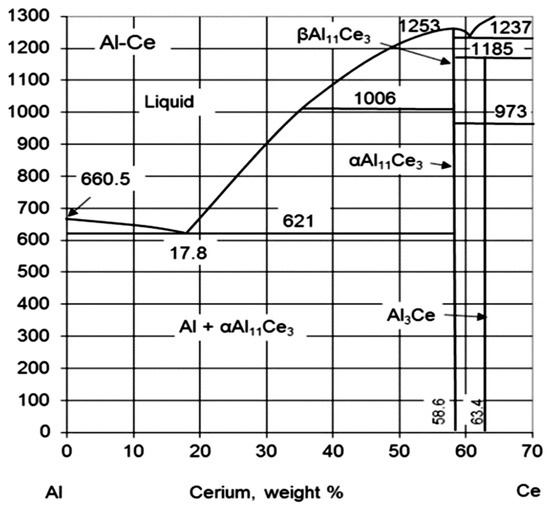
Figure 1.
Al-rich Ce partial phase diagram [12], with permission 5626391072716 (copyright license number).
3. Solidification Processing of Al-xCe Alloys
Solidification processes used to modify Al-Ce alloys are designed based on their microstructures. The microstructures of Al-Ce alloys are composed of an Al matrix and secondary intermetallic phases. According to Czerwinski and AmirKhiz [18], the microstructure of Al-Ce changes significantly depending on Ce content. The hypoeutectic group exhibits the proeutectic Al, with dendritic morphology representing about half of the surface area, and the eutectic is placed in the inter-dendritic regions. At Ce, the contents of 10 wt% eutectic dendrites disappear, and some fine white areas represent Al. Increasing Ce to 15 wt% enlarges the volume fraction of the Al11Ce3 intermetallic phase. Further, the increase in the amount of Ce to 20 wt% covers the whole microstructure with Al11Ce3 particles. Figure 2 [18] shows the morphological changes associated with increasing Ce content in the binary Al-Ce systems. Generally, processing Al-Ce alloys through solidification includes rapid solidification, solidification under mechanical/magnetic stirring, and the most recent method of ultrasonic-assisted solidification.
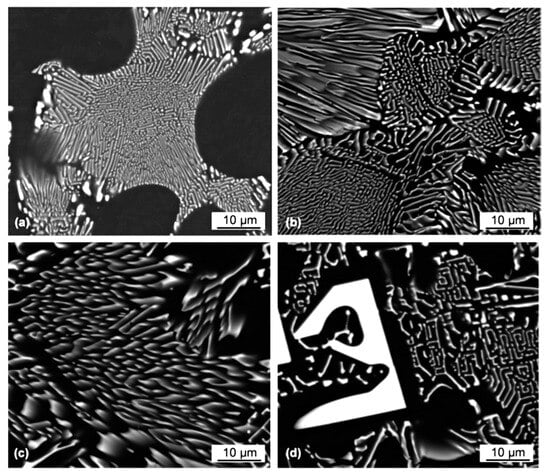
Figure 2.
SEM micrographs emphasizing the shape and volume fraction of Al11Ce3 in (a) Al-5Ce, (b) Al-10 Ce, (c) Al-15 Ce, and (d) Al-20 Ce alloys [18-Open access permission].
3.1. Rapid Solidification
Zhang et al. [19] investigated the rapid solidification effect (RS) on the intermetallic features of some Al-Ce alloys. It was observed that RS had a significant effect on the microstructure of Al-8Ce and -20Ce alloys while having no effect on the constituents of the alloy. On the other hand, the microstructure and alloy constituents were both influenced by the rapidly solidifying Al-36% Ce alloy.
Kozakevich et al. [11] established the relationship between the cooling rate and microstructure refinement of the Al-11Ce-3 Ni-1.2Mn alloy using a wedge-shaped mold. The size of both Al23Ce4Ni6 and primary Al11Ce3 phases was decreased in the range of 0.18 °C/s to 0.32 °C/s, which increased the high-temperature strength of the alloy. Increasing the cooling rate, which, thus, exceeds 1.36 °C/s, prevented the formation of Al11Ce3 and allowed the Al23Ce4Ni6 phase to nucleate.
Ye et al. [20] prepared a cast hyper eutectic Al-14 wt% Ce using a wedge-shaped copper mold. A transition from a hyper- to a hypo-eutectic microstructure occurred due to rapid solidification. This transition showed a clear interface at a cooling rate of 1598 K/S, while this interface became non-significant at lower cooling rates at which both primary Al11Ce3 intermetallic and eutectic colonies exist.
3.2. Processing via Mechanical/Magnetic Stirring
The solidification processing of aluminum alloys through mechanical or magnetic stirring proved to be efficient in terms of refining and fragmenting the secondary intermetallic phases [21]. The processing of Al-5 wt% Ce alloys through magnetic stirring was investigated by Wang et al. [16]. It was observed that the Al-Al11Ce3 eutectic shape changed from the lamellar to fibrous morphology when the melt was stirred at 630 °C using a permanent magnet and poured in a metallic mold. This fibrous structure provides promising mechanical properties that can be used to cast Al-5 wt% Ce alloy at high service temperatures.
In a recent technical report [22], the mechanical vibration setting shown in Figure 3 was used as an economical alternative to melt stirring. An Al-4 wt% Ce-10 wt% Mg alloy was prepared using an induction furnace. The liquidus was found to be around 645 °C. Therefore, three pouring temperatures were decided relative to the liquidus, namely 655, 665, and 675 °C. The melt was poured into vibrating metallic molds. The frequency of the mechanical vibrator was kept constant at 50 Hz during solidification. The vibration was held for 4 min after pouring the liquid aluminum. It should be noted that this time was sufficient to solidify the specimens. The solidified samples were then allowed to cool to room temperature. The preliminary microstructure investigation is summarized in Figure 4. Remarkably, applying the mechanical vibration at 655 °C, which is about 10 degrees above the liquidus, achieved the best combination of good fragmentation and homogenous distribution of Al11Ce3 intermetallic particles. At 665 °C, the particles were further refined; however, coarse particles were frequently observed in the microstructure. At 675 °C, particles were coarsened and inhomogeneously distributed. This finding suggests that the optimum mechanical vibration temperature to treat this alloy is 665 °C.
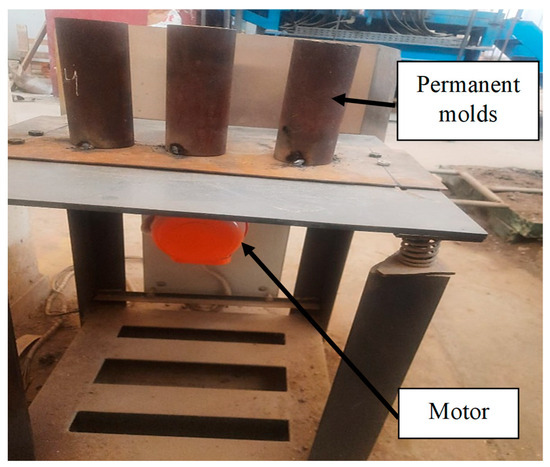
Figure 3.
The settings of the permanent molds and the mechanical vibrators.
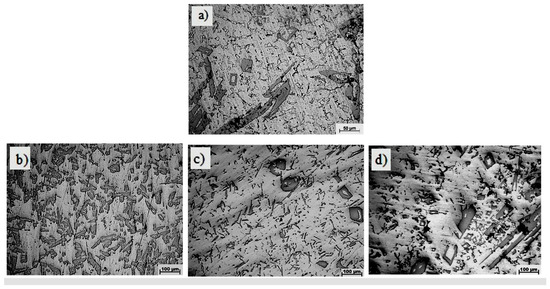
Figure 4.
Optical micrographs comparing the intermetallic particle size of (a) solidified alloys without and with mechanical vibrations at (b) 655 °C, (c) 665 °C, and (d) 675 °C [22].
3.3. Ultrasonic-Assisted Solidification
Based on the idea of melt agitation via magnetic stirring, solidification under ultrasonic vibrations has been developed. Eskin [23] reported that the high-frequency oscillations produced by ultrasonic waves induced cavitation and intensively mixed the melt constituents via acoustic streaming. The experimental studies [24,25,26] revealed that the refining action of ultrasonic treatment was not only based on the reduction in particle sizes, but also provided undercooling that was enough to cause the cavitation of these secondary particles during the solidification process. Ultrasonic treatment can principally refine the intermetallic particles via one of two mechanisms: dendritic fragmentation or heterogeneous nucleation, as suggested earlier [27]. If the melting temperature is under the liquidus, when the first solid starts to form, dendritic fragmentation occurs due to the interaction between the cavitation zone and the solidification front. This process leads to fragmenting dendrite grains and the multiplication of the grains [28]. On the other hand, if the melt temperature is between the melting temperature and the liquidus, the heterogenous nucleation is the dominant mechanism. In this case, three possible entire mechanisms can occur. The first mechanism is that ultrasonic-generated bubbles grow and explode, producing strong shock waves and increasing the local pressure, thus reducing the solidification temperature, which encourages nucleation in the cavitation melt volume (Le Chatelier principle) [29]. The second mechanism assumes that when bubbles grow, and the liquid inside of them evaporates, the bubbles’ temperature decreases, which causes the undercooling of the melt at the bubbles’ surface, which triggers nuclei and then disperses these nuclei in the melt upon explosion (Kapustina concept) [30]. The last heterogeneous nucleation mechanism considers the cracks on substrate surfaces and the inclusions that either exist in the melt or formed upon cooling to be wetted by the melt upon bubble explosions and act as effective nucleation sites (Eskin) [23].
In the works of El-Hadad et al. [17,30], solidification under ultrasonic vibration was carried out for the first time on Al-Ce alloys. An Al-10 wt% Ce alloy was processed at different pouring temperatures (645–665 °C) relative to the alloy liquidus (~644 °C). The Al11Ce3 intermetallic particles were fragmented (from ~30 μm to ~3 μm) and evenly distributed in the melt at the processing temperature of (655 °C), which was about 10 degrees above the liquidus (see Figure 5). This effect of ultrasonic treatment gradually dimensioned upon increasing the pouring temperature and coarse, and unevenly dispersed particles were observed at 665 °C. The mechanical properties were correspondingly affected, as the specimens processed at the optimum temperature showed the best wear resistance at room and high temperatures.
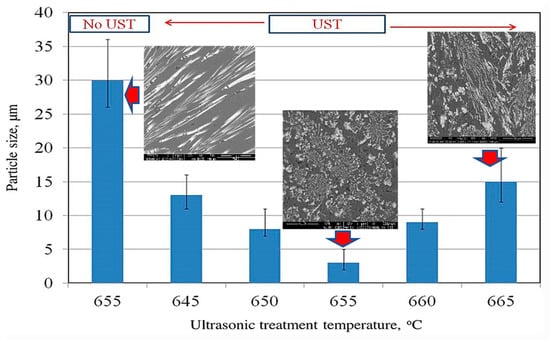
Figure 5.
Average Al11Ce3 particle size under different ultrasonic processing conditions [17] [edited-CCC permission].
In [30], the corrosion behavior of the Al-10 wt% Ce alloy prepared in [30] was studied in 3.5% NaCl solution. It was found that the corrosion resistance was significantly affected by the intermetallic particle size. The corrosion rate of the unprocessed samples was reduced from 0.00068 to 0.00006 mm/year, and the corrosion resistance increased from 71 to 343.8 kΩ, when the alloy was processed via ultrasonication at the optimum condition (655 °C). Moreover, increasing the processing temperature beyond the optimum coarsened the intermetallic phase and encouraged the pitting corrosion, as observed in the microstructure in Figure 6, of the corroded samples under different processing conditions.
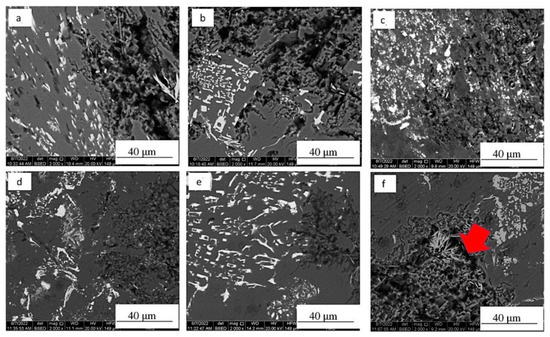
Figure 6.
SEM micrographs of the corroded samples showing the influence of ultrasonic processing on the pitting susceptibility of Al-10 wt% Ce alloy at (a) 655 °C (untreated) and when ultrasonically treated at (b) 645, (c) 650, (d) 655, (e) 660, or (f) 665 °C. [30-CCC permission].
4. Future Potential Research
Based on the above results of the ultrasonic-assisted solidification experiments, excellent structure refinement was achieved when the Al-Ce alloys were processed at the optimum treatment temperature. However, more efforts are needed to enable the use of powerful ultrasonic systems to modify the huge ingots in mass production processes.
Author Contributions
Conceptualization, S.E.-H., Methodology, M.E.M. and M.A., Writing original draft, S.E.-H., Review and editing, E.R., Supervision, R.B. and A.N. All authors have read and agreed to the published version of the manuscript.
Funding
This research was carried out under the auspices of a project funded by the Egyptian Science and Technology Development Fund (STDF) and DAAD-Germany, through grant ID: GE-SEED-43967.
Institutional Review Board Statement
Not applicable.
Informed Consent Statement
Not applicable.
Data Availability Statement
All the data were provided in the submitted manuscript.
Conflicts of Interest
The authors declare no conflict of interest.
References
- Totten, G.E.; MacKenzie, D.S. (Eds.) Handbook of Aluminum; Physical Metallurgy and Processes, Marcel Dekker Inc.: New York, NY, USA, 2003; Volume 1, pp. 599–604. [Google Scholar]
- Czerwinski, F.; Kasprzak, W.; Sediako, D.; Emadi, D.; Shaha, S.; Friedman, J.; Chen, D. High-Temperature Aluminum Alloys for Automotive Powertrains. Adv. Mater. Process. 2016, 174, 16–20. [Google Scholar] [CrossRef]
- Nikanorov, S.; Volkov, M.; Gurin, V.; Burenkov, Y.; Derkachenko, L.; Kardashev, B.; Regel, L.; Wilcox, W. Structural and mechanical properties of Al–Si alloys obtained by fast cooling of a levitated melt. Mater. Sci. Eng. A 2005, 390, 63–69. [Google Scholar] [CrossRef]
- Spigarelli, S.; Cabibbo, M.; Evangelista, E.; Cucchieri, S. Evaluation of the creep properties of an Al-17Si-1Mg-0.7Cu alloy. Mater. Lett. 2002, 56, 1059–1063. [Google Scholar] [CrossRef]
- Alkahtani, S.A.; Elgallad, E.M.; Tash, M.M.; Samuel, A.M.; Samuel, F.H. Effect of Rare Earth Metals on the Microstructure of Al-Si Based Alloys. Materials 2016, 9, 45. [Google Scholar] [CrossRef] [PubMed]
- Czerwinski, F. Cerium in aluminum alloys. J. Mater. Sci. 2020, 55, 24–72. [Google Scholar] [CrossRef]
- Ng, D.S.; Dunand, D.C. Aging- and creep-resistance of a cast hypoeutectic Al-6.9Ce-9.3Mg (wt.%) alloy. Mater. Sci. Eng. A 2020, 786, 139398. [Google Scholar] [CrossRef]
- Belov, A.; Khvan, A.V. Structure and Phase Composition of Alloys of the Al–Ce–Cu System in the Region of the Al–Al8CeCu4 Quasi-Binary Join. Russ. J. Non-Ferr. Met. 2007, 48, 45–50. [Google Scholar] [CrossRef]
- Belov, N.A.; Naumova, E.A.; Eskin, D.G. Casting alloys of the Al–Ce–Ni system: A microstructural approach to alloy design. Mater. Sci. Eng. 1999, A271, 134–142. [Google Scholar] [CrossRef]
- Weiss, D. Composites and Alloys Based on the Al-Ce System, Aluminium Alloys and Composites; IntechOpen: London, UK, 2020; Available online: https://www.intechopen.com/chapters/70002 (accessed on 10 July 2023).
- Kozakevich, J.; Stroh, J.; Mallouhi, V.; Sediako, D.; Weiss, D. Interplay Between Cooling Rate, Microstructure, and Mechanical Properties of an Al–Ce–Ni–Mn Alloy. Miner. Met. Mater. Soc. 2022, 83–91. [Google Scholar] [CrossRef]
- Okamoto, H. Al-Ce (Aluminum-Cerium). J. Phase Equilibria Diffus. 2011, 32, 392–393. [Google Scholar] [CrossRef]
- Sims, Z.C.; Rios, O.; Weiss, D.; Turchi, P.E.; Perron, A.; Lee, J.R.; Li, T.; Hammons, J.; Bagge-Hansen, M.; Willey, T.M.; et al. High performance aluminum-cerium alloys for high-temperature applications. Mater. Horiz. 2017, 4, 1071–1078. [Google Scholar] [CrossRef]
- El-Hadad, S.; Moussa, M.E.; Othman, M.; Nofal, A.; Riedel, E.; Baehr, R. Microstructure Control of Al-Ce Alloys: A Review. Int. J. Mater. Technol. Innov. 2022, 2, 83–87. [Google Scholar] [CrossRef]
- Guo, Y.L.; Hu, J.L.; Han, Q.F.; Sun, B.H.; Wang, J.S.; Liu, C.M. Microstructure diversity dominated by the interplay between primary intermetallics and eutectics for Al-Ce heat-resistant alloys. J. Alloys Compd. 2022, 899, 162914. [Google Scholar] [CrossRef]
- Wang, L.; Qi, R.; Ye, B.; Bai, Y.; Huang, R.; Jiang, H.; Ding, W. Improved Tensile Strength of Al-5Ce Alloy by Permanent Magnet Stirring. Met. Mater. Trans. A 2020, 51, 1972–1977. [Google Scholar] [CrossRef]
- El-Hadad, S.; Moussa, M.E.; Waly, M.A. Effects of Solidification under Ultrasonic Vibrations on Al11Ce3 Phase Fragmentation and Mechanical Properties of Al-10 wt.% Ce Alloy. J. Mater. Eng. Perform. 2022, 31, 5393–5408. [Google Scholar] [CrossRef]
- Czerwinski, F.; AmirKhiz, B.S. On the Al–Al11Ce3 Eutectic Transformation in Aluminum–Cerium Binary Alloys. Materials 2020, 13, 4549. [Google Scholar] [CrossRef]
- Zhang, Z.; Wang, Y.; Bian, X. Microstructure selection map for rapidly solidified Al-rich Al–Ce alloys. J. Cryst. Growth 2004, 260, 557–565. [Google Scholar] [CrossRef]
- Ye, J.; Dai, K.; Gao, M.; Chen, J.; Guan, R. Primary phase transformation mechanism in a hypereutectic Al-Ce alloy during rapid solidification. Mater. Lett. 2023, 340, 134172. [Google Scholar] [CrossRef]
- Apelian, D. Recent Advances in Solidification Processing. In Innovations in Materials Processing. Sagamore Army Materials Research Conference Proceedings; Bruggeman, G., Weiss, V., Eds.; Springer: Boston, MA, USA, 1985; Volume 30. [Google Scholar] [CrossRef]
- STDF (Sience and Technology Development Fund). A Project Report about “Solidification Processing of Al-Ce Alloys”; GE-SEED-43967; STDF (Sience and Technology Development Fund): Cairo, Egypt, 2023. [Google Scholar]
- Eskin, G. Ultrasonic Treatment of Light Alloy Melts; Gordon and Breach Science Publishers: Amsterdam, The Netherlands, 1998. [Google Scholar]
- Zhang, L.; Eskin, D.G.; Katgerman, L. Influence of ultrasonic melt treatment on the formation of primary intermetallics and related grain refinement in aluminum alloys. J. Mater. Sci. 2011, 46, 5252–5259. [Google Scholar] [CrossRef]
- Khalifa, W.; Tsunekawa, Y.; Okumiya, M. Effect of ultrasonic treatment on the Fe-intermetallic phases in ADC12 die cast alloy. J. Mater. Process. Technol. 2010, 210, 2178–2187. [Google Scholar] [CrossRef]
- Atamanenko, T.; Eskin, D.; Zhang, L.; Katgerman, L. Criteria of Grain Refinement Induced by Ultrasonic Melt Treatment of Aluminum Alloys Containing Zr and Ti. Met. Mater. Trans. A 2010, 41, 2056–2066. [Google Scholar] [CrossRef]
- Eskin, G.I.; Eskin, D.G. Ultrasonic Processing of Aluminum Alloys for Grain Refining. In Proceedings of the 12th International Conference on Aluminium Alloys, Yokohama, Japan, 5–9 September 2010; pp. 638–645. [Google Scholar]
- Hunt, J.D.; Jackson, K.A. Nucleation of Solid in an Undercooled Liquid by Cavitation. J. Appl. Phys. 1966, 37, 254–257. [Google Scholar] [CrossRef]
- Kapustina, O.A. The Physical Principles of Ultrasonic Manufacturing; Nauka: Moscow, Russia, 1970. [Google Scholar]
- El-Hadad, S.; Moussa, M.E.; Shoeib, M. Influence of Al11Ce3 Size and Distribution on the Electrochemical Properties of Sonoprocessed Al-10 wt.% Ce Alloy. Int. J. Met. 2022, 17, 1606–1614. [Google Scholar] [CrossRef]
Disclaimer/Publisher’s Note: The statements, opinions and data contained in all publications are solely those of the individual author(s) and contributor(s) and not of MDPI and/or the editor(s). MDPI and/or the editor(s) disclaim responsibility for any injury to people or property resulting from any ideas, methods, instructions or products referred to in the content. |
© 2023 by the authors. Licensee MDPI, Basel, Switzerland. This article is an open access article distributed under the terms and conditions of the Creative Commons Attribution (CC BY) license (https://creativecommons.org/licenses/by/4.0/).